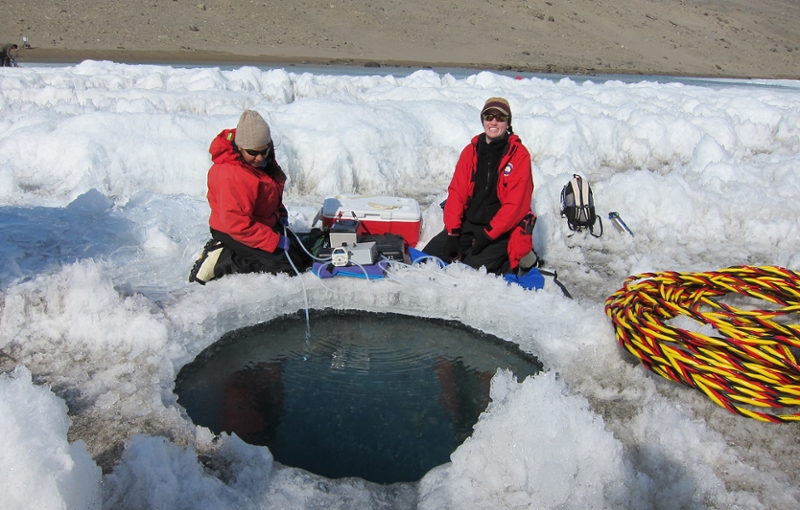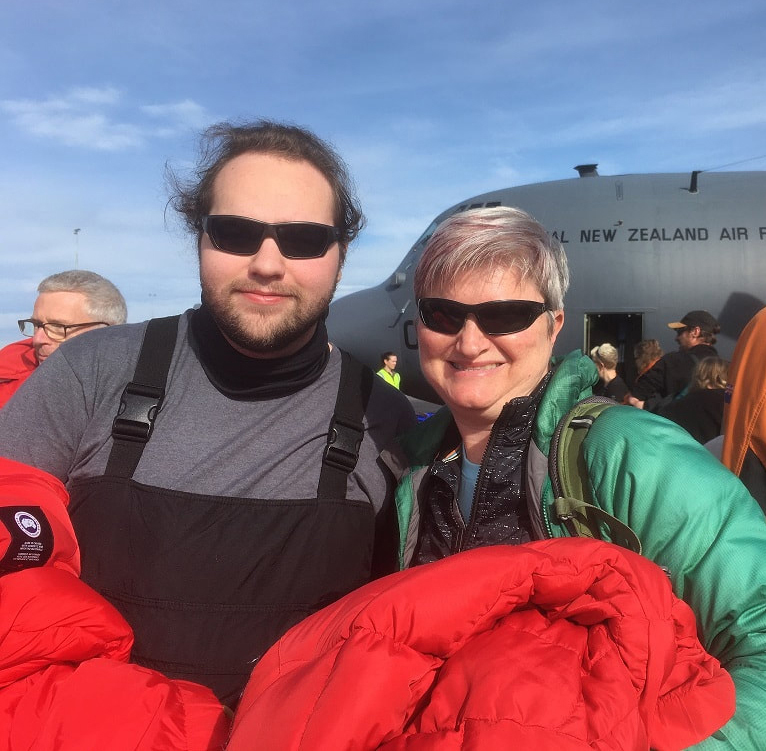
Polar deserts could provide first look at climate change effects in Antarctica
40+ Miami students have worked with Rachael Morgan-Kiss’ Antarctica research
By Susan Meikle, university news and communications

Rachael Morgan-Kiss (right), associate professor of microbiology, and graduate student Parnell Sheldon land on the ice at McMurdo, Antarctica Dec. 19 (photo by Shasten Sherwell).
Antarctica's McMurdo Dry Valleys is one of the few environments on Earth where living organisms are dramatically affected by minor changes in climate.
Miami University microbiologist Rachael Morgan-Kiss is one of dozens of scientists who have been investigating the polar desert’s ecosystems through the McMurdo Long Term Ecological Research (MCM LTER) project.
The first effects of climate change in Antarctica should be observed in the McMurdo Dry Valleys.
"While the Antarctic ice sheets respond to climate change on the order of thousands of years, the glaciers, streams and ice-covered lakes in the McMurdo Dry Valleys respond to change almost immediately," the MCM LTER scientists said.
Morgan-Kiss recently landed at McMurdo for the polar summer field season — marking the 20th year since her first expedition there as a doctoral student.
She and her graduate students Shasten Sherwell and Parnell Sheldon left Ohio last month. This is Sherwell’s third, and Sheldon’s first, expedition to Antarctica.
They will conduct experiments and collect samples and data, returning to Oxford in February.

Follow their "Field Season 2019/2020 Blog" for photos and updates.
Morgan-Kiss’ research with Antarctic microbes has been supported by the National Science Foundation (NSF) since she joined Miami in 2007.
Her work has involved more than 30 Miami undergraduate and 11 graduate students.
Currently she is part of a $3.38 million NSF MCM LTER research grant that supports nine principal investigators from eight universities to document and understand how the McMurdo Dry Valley ecosystems respond to environmental change.
Read a recent story about her research here: Antarctic algae, alternative photosynthesis and art.

Graduate students Isha Kalra (left) and Shasten Sherwell collect samples in the McMurdo Dry Valleys, in 2019.
Long-Term Ecological Research
The NSF funded the first Long Term Ecological Research (LTER) site in 1980. Today, research programs at 28 LTER sites nationwide support long-term and large-scale ecological research.
Miami scientists are involved in research at two of these LTER sites — MCM and the Hubbard Brook Experimental Forest of New Hampshire. Miami researchers also are involved in two NSF-funded Long Term Research in Environmental Biology (LTREB) sites — at nearby Acton Lake and at Lake Lacawac in Pennsylvania's Pocono Mountains.
Miami has had a scientific presence in Antarctica since 1980, first with Bill Green, professor emeritus of interdisciplinary studies, and Rick Lee, University Distinguished Professor of Biology emeritus.
Did you know?
- This year marks the 200th anniversary of the first recorded human sighting of Antarctica in January, 1820, by Russian explorers.
- Last month marked the 60th anniversary of the signing of the Antarctic Treaty, on Dec. 1, 1959. Twelve nations signed the international agreement that set aside territorial claims and established Antarctica as a place for peaceful coexistence to facilitate scientific research by all nations. Since then, 54 nations have signed on to the treaty. The United States Antarctic Program is managed by the National Science Foundation.
- The U.S. researchers are based at McMurdo Station, which began in 1956 as an improvised naval base. Construction will begin next year on a 10-year modernization of the station. Read the Jan. 6 New York Times story "The Coolest Architecture on Earth is in Antarctica” for a view of McMurdo and other nations' research stations.
